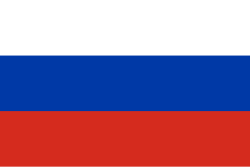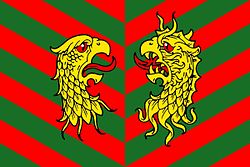 | |
| Proportion | 1:2 |
|---|---|
| Adopted | 29 October 1992 |
| Design | A horizontal tricolour of blue, white, and yellow in 2:1:1 with a yellow Soyombo symbol on the hoist of the blue band. |
| Designed by | N. Batuyev, V. Abayev, S. Kalmykov |
 | |
| Use | Standard of the president of the Republic of Buryatia |
The state flag of the Buryat Republic [a] in southeastern Russia is a horizontal tricolour of blue, white and yellow in a 2:1:1 ratio with a yellow Soyombo symbol on the hoist of the blue band. It was officially adopted on 29 October 1992, after the dissolution of the Soviet Union.




























